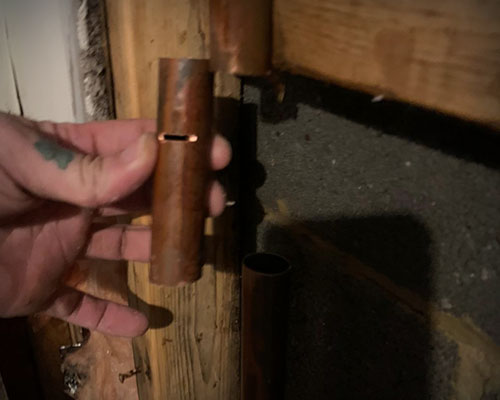A burst pipe water damage event can occur suddenly, causing extensive destruction to your home or business. The water rapidly flooding your space can severely damage walls, flooring, and furniture, and mold can start developing within just 24-48 hours. In such situations, prompt and professional action is crucial.
If you can spot the signs of a burst pipe early, you can act fast and prevent serious damage. Common signs of a burst pipe include sudden water leakage, decreased water pressure, unusual pipe noises, and wet patches on walls or ceilings. Quickly recognizing these signs helps minimize damage and restoration costs.
Flood Damage Pro is a water damage restoration company specializing in comprehensive recovery from water damage. We will become your reliable partner during this challenging situation.
Act swiftly - every minute counts when dealing with burst pipe water damage!
Broken Pipe Leaks Damage and Restoration
When dealing with broken pipe leaks damage, quick intervention and professional restoration are essential. Flood Damage Pro expertly handles all aspects of damage restoration, ensuring your property returns to its original condition safely and effectively.
Why Is a Burst Pipe Serious?
Unlike a typical leak, burst water pipe damage can lead to extensive destruction within minutes. Water destroys building materials, furniture, electrical wiring, and creates ideal conditions for rapid mold and bacteria growth. Delaying professional intervention only exacerbates the situation, dramatically increasing repair costs.
Water can seep into hard-to-reach areas where mold develops, posing severe health risks, causing allergies, and respiratory issues. Additionally, excess moisture may lead to structural damage, causing serious safety concerns for your property.
First Steps During a Burst Pipe Emergency: Safety First
When you encounter a burst pipe emergency, it's crucial to act immediately:
- Quickly shut off the main water valve to stop further flooding.
- Turn off electricity in the affected area to prevent electric shock.
- If water levels are high, evacuate the premises, particularly basements or lower floors.
- Contact emergency services or immediately call our burst pipe specialists for professional assistance.
These immediate actions prevent further damage and protect your health and property. It's essential to understand that attempting to resolve the issue yourself, without proper skills and equipment, can be dangerous and ineffective.
Professional Restoration: Step by Step Process
Flood Damage Pro provides a comprehensive approach to addressing the aftermath of burst pipe water damage:
- Rapidly extracting water using specialized equipment to minimize further damage.
- Removing damaged drywall, flooring, furniture, and other irreversibly affected materials to prevent further deterioration.
- Thoroughly drying your space using powerful dehumidifiers and fans, with real-time humidity monitoring to ensure effectiveness.
- Conducting a detailed mold inspection using specialized equipment to detect even hidden growth, swiftly addressing any issues.
- Professionally cleaning and disinfecting affected areas with environmentally safe agents.
- Conducting thorough monitoring and final inspection to ensure complete restoration and client satisfaction.
Why Choose Flood Damage Pro?
We have over 20 years of experience managing water damage restoration services, establishing itself as a trusted and competent partner.
Our team has extensive expertise and professionalism, IICRC-certified, and regularly undergoing additional training to ensure exceptional service quality. We provide a 100% satisfaction guarantee and promptly address any client concerns. Our 24/7 availability guarantees immediate response to any emergency situation.
Call us now at 866-869-4167 right away!
Prevention of Burst Pipes
Understanding what causes a pipe to burst is crucial for prevention, especially during colder weather. Pipes burst commonly due to:
- Freezing temperatures
- Corrosion
- High water pressure
- Aging pipes
- Improper installation
To protect your home, insulate pipes, conduct regular plumbing inspections, promptly replace old or damaged pipes, and use leak detection systems that provide automatic alerts.
Areas of Service
We proudly serve customers throughout Maryland, Virginia, Baltimore, Washington, DC, New Jersey, New York, and Miami, offering prompt and professional water damage restoration services in these regions.
Call Us for Immediate Help After a Pipe Bursts
Timely and professional restoration after a burst pipe emergency helps you avoid substantial damage and quickly resume normal life. Flood Damage Pro is always by your side, ready to assist you during any emergency.
Contact us by phone at 866-869-4167 or fill out the assessment request form on our website. We'll promptly respond with professional advice. Call us now - don't lose precious time!
FAQs
What should I do immediately after a pipe bursts?
Shut off the main water supply and electricity in the affected area, document the damage, and call Flood Damage Pro or emergency services immediately for professional assistance.
How can I prevent pipes from bursting during cold weather?
Insulate exposed pipes, seal drafts around openings, let faucets drip during cold snaps, and maintain consistent indoor temperatures to reduce freezing risk.
How long does water damage restoration typically take?
Water damage restoration usually takes about 1-3 days, depending on the extent of the damage and drying conditions.
Does homeowners' insurance cover burst pipe damage?
Typically, homeowners' insurance covers water damage from sudden burst pipes. Always review your specific policy and consult with your insurance provider.
How can I detect a burst pipe?
Common signs include decreased water pressure, discolored water, water stains on walls or ceilings, and unusual noises from pipes.
How soon can mold develop after water damage?
Mold can start developing within 24-48 hours after water damage occurs, making immediate professional drying and cleaning essential.

Call now for an on-site evaluation and inspection for emergency services


On every job
CALL FLOOD DAMAGE PRO
